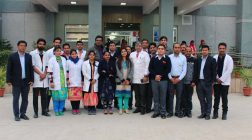Opportunities For Healthcare Innovation SXSW Hipsters May Have Missed
David Shaywitz, Contributor
Since Lisa Suennen already captured beautifully the distinction between the SXSW and HIMSS crowds last year, I won’t belabor the point, other than to say that with all the ties and blue blazers present at today’s Real Endpoints Symposium in Philadelphia, no one would mistake the attendees for Austin hipsters; I was grateful not to get tossed for wearing jeans.
Unfortunately, I suspect that ma ny of the hoodied SXSW technologists interested in digital health might have found today’s discussions especially illuminating, highlighting some of the key healthcare problems to be solved, and featuring many (but not all) of the key players. Pharmas, device makers, diagnostic companies, and payors seemed well-represented; providers: less so. Patients: essentially absent (I suspect in future years, forward-thinking disease foundations such as the Michael J Fox foundation and the Myelin Repair Foundation might find the dialog especially useful).
ny of the hoodied SXSW technologists interested in digital health might have found today’s discussions especially illuminating, highlighting some of the key healthcare problems to be solved, and featuring many (but not all) of the key players. Pharmas, device makers, diagnostic companies, and payors seemed well-represented; providers: less so. Patients: essentially absent (I suspect in future years, forward-thinking disease foundations such as the Michael J Fox foundation and the Myelin Repair Foundation might find the dialog especially useful).
Given my basic thesis that one of the most exciting areas of future healthcare innovation is likely to be at the intersection of biopharmaceuticals, healthcare reform/reimbursement evolution, and digital health (including a conspicuous focus on the patient), let me highlight several potential entrepreneurial opportunities discussed today.
There will be a market for trusted technical assessment of new medical products; many entities could theoretically do this, but most likely a new entrepreneur-developed company will succeed.
This is the key thesis of conference organizer Roger Longman, who hopes “Real Endpoints” (he is CEO) will be this company, though he readily acknowledges the winner could also be someone else. The idea is that trusted assessments of both (real-world) clinical efficacy, and relevant costs (of products and potentially of savings), would be of exceptional use to many stakeholders, and having a neutral party do this would make sense for many reasons. While government agencies (or government-initiated agencies such as the Patient-Centered Outcomes Research Institute [PCORI]) or academic groups could theoretically do this, they are unlikely to be agile or efficient enough to operationalize this in a robust enough fashion, Longman argues. One question, raised by an audience member, is whether an individual company will have adequate access to enough data to make these determinations. Another question is how applicable such generalized or standardized assessments are likely to be in specific care settings.
Existing EMR systems are suboptimal, and better approaches are needed.
Sloan-Kettering’s Peter Bach made this point most clearly, asserting “EMRs were made for malpractice and billing” (i.e. not for patient care), and “when I’m not servicing the EMR record, I take care of patients.” As I’ve discussed before, not only does it seem that many EMRs were designed without a sensitivity to the nuances of patient care, but there’s an additional concern that EMRs may be locking in legacy processes that perhaps should first be redesigned. Other speakers emphasized the challenge of integrating information emanating from the over 600 EMR systems said to be in use today, creating a significant intraoperability challenge.
Focusing on technical assessment of new medical products may miss the point.
One of the most interesting comments of the day came from PCORI Executive Director Joe Selby, who said that when he travels around the country to ask people about their care, he doesn’t detect much interest in tech assessment, but rather in access to care, coordination of care, delivery of care, and (especially in rural areas) access to telemedicine. I’m not sure what the exact equivalent is for the hashtag “#firstworldproblems,” but that’s the sentiment: instead of arguing whether reimbursement should be higher for drug A or drug B, Selby emphasizes we should be sure that patients are actually receiving the basic aspects of care to begin with.
On the other hand, a rigorous, trusted approach to tech assessments might help out a lot, especially in areas such as diagnostics.
There was a lot of thoughtful dialog on this point, perhaps best captured by Crescendo Bioscience’s Ted Snelgrove, who observed, “there isn’t one body that does tech assessment in a way that matters,” which complicates reimbursement efforts for diagnostic companies such as his. Even more interestingly, he offered an insightful critique of the current practice of using as a reimbursement criteria whether a diagnostic is likely to impact clinical decision making; in his view, this simply “outsources” decisions about use of diagnostics to clinicians – which I interpreted to mean a product might have demonstrated utility and perhaps should be used, even if some clinicians may not recognize this yet. This resonates with the comments of Vinod Khosla and others that it’s effectively impossible to expect doctors to keep up with scientific advances, and approaches that helped doctors do this could enable better care. Khosla seemed to be thinking more about IT systems, but perhaps a tech-assessment service could similarly help drive more rapid adoption of useful innovations.
Many pharma companies will be earnestly seeking ways to make their products more valuable.
I’ve been keenly interested in the question of how pharmas will approach digital health space; Matt Hendricks has discussed this thoughtfully as well. Today, Merck’s Jay Galeota offered one of the clearest articulations of a pharma vision around this space that I’ve heard to date, emphasizing that while Merck continues to believe that the most important source of value comes from their labs, they also appreciate there’s an important opportunity to make lab innovations more valuable. In particular, he emphasized the need “to enhance – to more actively manage the performance of our products.” In this statement, Galeota succinctly captures a key way pharma has changed: the goal has evolved from simply getting a product approved an on the market to ensuring it’s able to be as useful and effective as possible. The clear takeaway here is that digital health approaches that demonstrably enhance and document the utility of drugs and devices are likely to be of exceptional value to medical product companies.
A couple of final points, in the spirit of Woody Allen’s classic signoff, “I wish I had some kind of affirmative message to leave you with. I don’t. Would you take two negative messages?”
Message 1: As William Goldman observed, “Nobody knows anything”: An investor in the audience told me today, he knew pharmas were struggling to figure out how to get R&D to work, but said he hadn’t appreciated how payors were struggling just as much to figure out how to approach reimbursement. I’m struck by the incredible degree of flux the healthcare systems is experiencing right now; there are sea-changes underway, especially related both to emerging technologies (such as “next generation sequencing,” anxiously discussed by some today) and the implementation of the ACA (also a source of anxiety for many), and it seems unclear to anyone how all of this will settle out. Apparently, the only sure investment would be in anxiolytics.
Message 2: Behavior change is hard. On the patient side, it’s clear that a huge fraction of the total costs of care reflect behavioral factors that could in theory be modified – if only someone could figure out how. On the physician side, several speakers highlighted research (e.g. this 2012 Health Affairs article from researchers at the RAND corporation) demonstrating how difficult it is to change physician behavior, even in the face of compelling data.
Troubling news for many – but inspiration for those intrepid and visionary entrepreneurs able to see these seemingly intractable challenges as the important opportunities they also represent.










